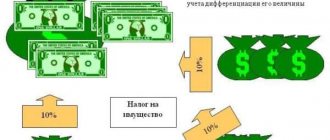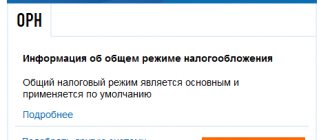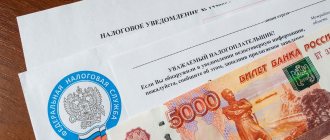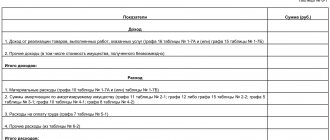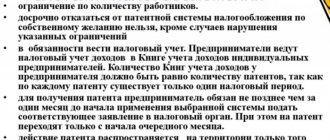General accounting points
One way or another, farm accounting revolves around inventory. Specialists monitor data on receipt and use of materials.
Particular attention is paid to the costs of receiving products and determining costs. The specific nature of the activities of peasant farms requires taking into account the natural loss of raw materials or agricultural products when reflecting accounting data.
Primary data, as a rule, is reflected in accounting in quantitative terms. Determining the cost of manufactured products has a number of features. In this case, crop production, livestock farming, and raw material processing have their own nuances.
Taxation of farming activities
When choosing a taxation system, the specifics of the peasant farm's activities, expected income, turnover and other factors are taken into account. OSNO is most often used in case of loss of the right to unified agricultural tax or simplified tax.
The mode is basic. When registering, it is selected automatically.
To switch to the simplified tax system or agricultural tax, the taxpayer submits a corresponding application to the Federal Tax Service within the prescribed period.
Who can use special modes? All farms that meet the conditions established by current legislation. For the application of the simplified tax system, for example, there are restrictions on turnover, the amount of fixed assets, and the average number of employees. The use of unified agricultural tax is possible at a certain size of the share of agricultural products.
Recognition of income and expenses for simplified and agricultural taxes is carried out using the cash method. Under OSNO, the accrual method can be used. The main tax under the simplified tax system is a tax that replaces the income tax, VAT. Under Unified Agricultural Tax, peasant farms pay agricultural tax. Businesses use OSNO to calculate income tax and other taxes.
When simplified, the tax base can be determined taking into account income or the difference between income and expenses. There is one way of determining it available to users of the Unified Agricultural Tax – income minus expenses. The tax base for OSNO is determined in a similar way.
Most often, farms operate on agricultural taxes. This is due to the presence of a number of preferences, including the payment of certain taxes (VAT, property and others). The advantages of the regime also include a simplified reporting and accounting procedure.
Simplified system: main aspects
A farm whose founder has the status of an individual entrepreneur can operate on the basis of a simplified taxation system. If the management of the farm plans to work under the simplified tax system, you need to submit a corresponding application to the tax authority immediately upon registration. This feature significantly distinguishes the simplified tax system from the previous taxation system.
Depending on the level of activity and the scale of expenses that the company incurs, its founder can choose the “Income” or “Income minus expenses” system. In the first case, the income tax provides for a 6% tax, in the second - 15%.
Under the simplified taxation system, the declaration requires the submission of the following reporting forms:
declaration under the simplified taxation system - in accordance with Art. 346 of the Tax Code (https://www.consultant.ru/document/cons_doc_LAW_28165/bc20a061630473795bd6b2cce4f0201912e9c97e/), must be submitted no later than April 30 of the year following the reporting period;- book of expenses and income: in accordance with the provisions of the Tax Code (https://www.buhgalteria.ru/nalogoviy-kodeks/glava3/stat23/), must be provided if there are relevant requirements. Otherwise, accounting reporting under the simplified tax system is simplified.
In cases where a farm operates under the simplified tax system, being an LLC, the tax authorities require additional forms to be filled out. As a rule, these are the same forms of accounting reporting, land and transport taxes.
Features of the use of unified agricultural tax
Expert opinion
Soloviev Ilya Mikhailovich
Lawyer with 10 years of experience. Specialization: civil law. Extensive experience in developing legal documentation.
Agricultural tax can only be used by farms for which the relevant activity is the main one. The share of income from the sale of agricultural products must be 70% or more.
Existing peasant farms, users of the simplified tax system or OSNO, can switch to the unified agricultural tax from the beginning of the new calendar year. New companies are advised to submit an application for a change in tax regime at the same time as their registration documents.
Unified agricultural tax users have to report to the tax authorities once a year – in March. Summary data is entered into the Unified Agricultural Tax declaration, according to the book of income and expenses. It is important to take into account the existence of restrictions on allowable costs.
The agricultural tax rate is 6%. It is paid in two stages: advance payment - until July 25 of the current year, actual - until April 1 of the year following the reporting one. In case of delay, the taxpayer is charged a penalty.
Penalties are also provided for failure to submit a declaration and non-payment of taxes. Forgot to submit a report and pay your budget? Be prepared to pay 20% of the assessed tax amount.
Peasant farm reporting in 2020
The maximum period for this procedure is March 31 following the reporting period. The popularity of the Unified National Tax Service is facilitated by this simplified format for filing a declaration; in addition, the list of documents submitted to the tax service is not too extensive.
One of the important requirements for taxpayers who have chosen a single agricultural tax is the mandatory maintenance of a book of income and expenses. It is no longer subject to certification by the Federal Tax Service this year.
Before March 1, reporting in the RSV-2 form must be submitted to the territorial branch of the Pension Fund corresponding to the entrepreneur’s registration address. This form is approved by a special resolution of the Board of the Pension Fund of the Russian Federation dated 2020 (). It is the content of this regulatory act that determines the specific list of documents and the format of the tax return submitted by an individual or legal entity.
Current accounting nuances
Now is the time to understand the specifics of accounting. Let's start with property. If a peasant farm operates on a single social tax or unified agricultural tax, the obligation to take into account property data in separate registers does not arise. For OSNO users, such accounting remains relevant.
Forms of internal accounting of property of peasant farms are determined independently. Books of the 1-KX form are most often used. Separate sections take into account data on plots, perennial plantings, fixed assets, equipment, machinery, transport, and working capital. Also a separate type of property is productive, draft and fattening livestock.
Intangible assets are also subject to mandatory registration. Their cost is formed in the same order as the OS.
The initial cost is determined based on actual acquisition costs. Intangible assets of a farm include copyrights, breeding innovations for production, processing of products, licenses (including software), patents for plant varieties, rights to use natural resources.
Intangible assets are included in expenses by depreciation. The period of their use is determined by the period of expected receipt of economic benefits.
Another mandatory accounting item is wages for farm workers. Labor relations are formalized in accordance with the Labor Code. For salary accounting, such primary documents as time sheets, work orders, travel tickets, accounting sheets, registers and payroll sheets are important.
KF X has the status of a legal entity or individual entrepreneur with the right to hire employees. In wage accounting, primary documents are used to record personnel and their labor:
- Time sheets.
- Work orders for piecework work.
- Vehicle waybills.
- Registers and accounting sheets.
- Sheets for calculating and issuing wages.
Amounts received by employees for wages are subject to income tax. The peasant farm acts as a tax agent in relation to the staff and has the obligation to withhold tax and pay it to the budget.
Peasant farm insurance premiums and reporting frequency
Expert opinion
Soloviev Ilya Mikhailovich
Lawyer with 10 years of experience. Specialization: civil law. Extensive experience in developing legal documentation.
Amounts of accrued wages to farm personnel are subject to insurance contributions transferred to the funds. The rate of each type of contribution is determined depending on the chosen taxation system.
Contributions and reporting on them came under the administration of the Federal Tax Service. In the Social Insurance Fund, control is carried out only on deductions for injuries and occupational diseases, for which an abbreviated report must be submitted.
In this article we will talk about taxation and reporting in peasant farms (peasant farms).
What is a peasant farm?
A peasant farm is a commercial organization that produces, sells and processes agricultural products or provides services in this area (the latter came into force in 2020). The activities of peasant farms are regulated by Federal Law No. 74 “On Peasant Farming”.
A farm can be registered as a legal entity, but most often the head is registered as an individual entrepreneur.
By default, in the system for calculating taxes, pensions and insurance contributions, peasant farms operate at the individual entrepreneur level - that is, they submit the same reports and have the same benefits.
Types of taxation of peasant farms
Among farms, the Unified Agricultural Tax is most often used - an agricultural tax, which was actually introduced specifically for peasant farms. But, nevertheless, other tax systems are available to both organizations and individual entrepreneurs in the field of agriculture.
In each taxation system, LLCs (unlike individual entrepreneurs) additionally submit transport and land tax declarations (until February 1), accounting reports and information on financial results (until March 31).
The peculiarity of the unified agricultural tax lies in the relaxed requirements for record keeping and benefits provided specifically for peasant farms. However, farms do not use it by default immediately after registration, but must submit an application to the Federal Tax Service about their intention to use the unified agricultural tax.
This can be done within a month after registering with the tax office in order to immediately begin your work on the Unified Agricultural Tax, or before December 31 - in order to begin applying the regime from January 1 of the next year.
The tax rate under the Unified Agricultural Tax is 6% of net profit (income minus expenses). Based on the decision of local authorities, the percentage is sometimes reduced to 4%.
The following have the right to use the Unified Agricultural Tax:
- Manufacturers of agricultural products, organizations processing and selling them. At the same time, income from the sale of own farm products must be more than 70% of the total.
- Agricultural consumer cooperatives, in which more than 70% of their income comes from the sale of products produced by members of the cooperative.
- Individual entrepreneurs and fishing enterprises with an average annual number of employees of less than 300, with income from the sale of catch in relation to total revenue of more than 70%.
- Organizations providing agricultural services.
To switch to the Unified Agricultural Tax, an enterprise must produce or sell agricultural products. For example, it is unacceptable to only process it.
All entrepreneurs who have chosen the Unified Agricultural Tax must maintain an accounting book (KUDiR). From 2020, it no longer needs to be certified by the Federal Tax Service, which also applies to peasant farms on the Unified Agricultural Tax.
Tax reporting is submitted in the form of a Unified Agricultural Tax declaration annually, until March 31 of the following year. Advance payment under the Unified Agricultural Tax is made until July 25, and full tax payment is due until March 31 of the next calendar year.
The deadline for submitting reports to the tax office is January 30 of the year following the reporting year, using the form “Calculation of insurance premiums.” The second section is completed.
Other possibilities of the Unified Agricultural Tax:
- Write-off of fixed assets when they are put into circulation;
- Inclusion of advance payments in the income item;
- Exemption from property tax, VAT and personal income tax.
To apply the simplified tax system “Income” or “Income minus expenses”, you must submit an application to the tax office. It is better to do this immediately, when registering a company.
Expert opinion
Soloviev Ilya Mikhailovich
Lawyer with 10 years of experience. Specialization: civil law. Extensive experience in developing legal documentation.
Peasant farms with minimal expenses prefer the “income” system (6%), and farms that have a significant share of expenses and are able to confirm them choose the “income minus expenses” system (profit tax is 15%).
Regional authorities can reduce the simplified tax rate by 1% on “income” and up to 5% on “income minus expenses.”
Accounting for peasant farms using the simplified tax system is also simplified. The farm must maintain KUDiR and provide it to the tax service upon request.
The simplified declaration must be submitted to the Federal Tax Service once a year, before April 30. The tax is paid quarterly: three times in advance before the 25th, and the final tax for the year - until April 30.
Peasant farms in most situations are equated to individual entrepreneurs, therefore, regardless of the form of the legal entity, it can reduce the tax on the entire amount of insurance premiums for the head and other members, without a limit of 50% only if the labor of hired workers is not used.
The general taxation regime is used in peasant farms extremely rarely and only when necessary. The complexity and volume of peasant farm reporting on OSNO is inferior to other options, but the main system allows farmers to cooperate with large network partners who deal only with VAT.
OSNO employs the majority of wholesale buyers who may be of interest to farmers. The fact is that the general regime allows wholesalers to significantly reduce the VAT burden. This regime will be applied to a newly formed farm automatically if its head does not have time to submit an application for the application of the simplified tax system or unified agricultural tax.
For some peasant farms, income tax can be reduced to zero. The full list of preferential areas is reflected in Article 284 of the Tax Code.
Automatically, all participants and the head of the farm are exempt from personal income tax payments for five years on income from the production, sale and processing of agricultural products.
It is legal to use this benefit only once - intentional re-registration of peasant farms is punishable by law. Income from activities not related to agriculture and farming is taxed without special benefits. Government subsidies and grants are not taxed.
The VAT return is submitted to the tax office once a quarter (in January, April, July and October before the 25th). Every year until April 30, forms 3-NDFL and 4-NDFL are provided. These requirements apply to both individual entrepreneurs and LLCs. Form 3-NDFL must be submitted even if there was no profit.
The company's reporting on OSNO also includes quarterly submission of income and property declarations.
Peasant farms on OSNO pay:
- Property tax;
- Land tax;
- Transport tax;
- Personal income tax (withheld from the wages of all hired employees);
- VAT;
- Mandatory insurance contributions.
Reporting to government funds
For members of peasant farms there are fixed insurance rates that do not depend on the minimum wage and are relevant for individual entrepreneurs.
The head of a farm that does not have hired employees is obliged to submit to the tax office every year on January 30 the calculation of insurance premiums for himself and for members of the peasant farm, filling out the 2nd section. The report can be provided in both paper and electronic format.
Insurance premiums must be paid before the end of the calendar year. This can be done in one payment or quarterly.
In addition, peasant farms are required to report to the state statistics service:
- Peasant farms with agricultural crops report annually before June 11 using form No. 1 - farmer.
- Peasant farms with livestock of farm animals report on form No. 3 - farmer until January 6.
Reporting for employees
If a peasant farm hires workers, then new obligations arise along with them.
Employees must provide the following to the tax office:
- Form 2-NDFL for each employee (until April 1);
- Form 6-NDFL (quarterly until the end of January, April, July and October and one annual along with 2-NDFL);
Personal income tax withheld from employees' salaries must be transferred to the state no later than the day following the date of issue to the employee.
Calculation of insurance premiums is submitted to the Pension Fund quarterly, before mid-February, May, August and November. By the 15th day of each month, information about insured persons (SZV-M) is provided.
Form 4-FSS is submitted to the Social Insurance Fund; it must be submitted before the twentieth of January, April, July and October, if in paper form and before the 25th in electronic format. Once a year, before April 15, LLCs must confirm their main activity with the Social Insurance Fund.
Contributions to the Pension Fund and Social Insurance Fund for employees are made until the 15th of the next month.
Search Tags
Calendar of events and developments
- Current events Agro Tatarstan
Video reports
- Video categories
- Reports and news
- Training and webinars
- Rabbit breeding
Official partner of TAT-FARMER
-Calendar of events and development of Tatarstan-
Taxes and reporting
So, you have submitted a notification about the transition to the unified agricultural tax. After you have been recognized as an agricultural tax payer, your peasant farm is exempt from paying the following taxes:
- You lose your VAT payer status. Tax obligations arise only when a peasant farm imports products, as well as under concession agreements;
- Peasant farms do not pay income tax, except in situations where profit from dividends is calculated;
- Farming is completely exempt from property taxes.
In addition to the agricultural tax, paid once a year, you have obligations to pay other taxes and fees provided for by law. Thus, peasant farms registered as legal entities pay contributions to extra-budgetary funds and, if they have vehicles, transfer transport tax. Similar obligations are provided for by law for individual entrepreneurs - heads of peasant farms. In the event that your farm is recognized as an environmental polluter (for example, when dumping pesticides into the soil), the peasant farm is obliged to pay.
As for reporting, peasant farms are obliged to provide the Federal Tax Service with a fairly impressive list of reporting documents. Let's present them in the form of a table.
| No. | Name of the reporting document | Where is the document submitted? | Description | Deadline |
| 1 | Declaration of Unified Agricultural Tax | Contains the calculation and amount of tax paid by the farm at the end of the year | Annually until March 31 (for 2020 – until 03/31/17) | |
| 2 | Report on the average number of employees of peasant farms | Federal Tax Service authority at the place of registration of the peasant farm (for individual entrepreneurs – heads of peasant farms – at the place of residence) | Contains data on the average number of employees at the end of the year. Provided when the farm has hired workers. | Annually until January 20 (for 2020 – until 01/20/17) |
| 3 | Help 2-NDFL | Federal Tax Service authority at the place of registration of the peasant farm (for individual entrepreneurs – heads of peasant farms – at the place of residence) | The certificate includes information on income paid by peasant farms to employees at the end of the year. | Annually until April 01 (for 2020 – until 04/01/17) |
| 4 | Help 6-NDFL | Federal Tax Service authority at the place of registration of the peasant farm (for individual entrepreneurs – heads of peasant farms – at the place of residence) | The certificate includes information on the amounts of personal income tax paid for hired employees at the end of the year. | Quarterly until the end of the next month (for the 1st quarter of 2020 - until 04/30/17). |
| 5 | Form 4-FSS | FSS | Contains data on the amounts of compulsory social insurance contributions paid by peasant farms for employees in the reporting year. | Quarterly until the 20th day of the next month (for the 1st quarter of 2017 - until 04/20/17). |
| 6 | Form RSV-1 | PF | The certificate includes information on the amounts of contributions for health insurance and pensions paid for hired employees at the end of the year. | Quarterly (for the 1st quarter of 2020 – until 05.15.17). |
| 7 | Form SZV-M | PF | Contains information about insured employees who are on the staff of the peasant farm. | Annually until January 10 (for 2020 - until 01/10/17). |
Taxation of peasant farms and what you need to know
Types of taxation of peasant farms
Unified Agricultural Tax The peculiarity of the unified agricultural tax lies in the relaxed requirements for record keeping and benefits provided specifically for peasant farms. However, farms do not use it by default immediately after registration, but must submit an application to the Federal Tax Service about their intention to use the unified agricultural tax.
This can be done within a month after registering with the tax office in order to immediately begin your work on the Unified Agricultural Tax, or before December 31 - in order to begin applying the regime from January 1 of the next year.
The following have the right to use the Unified Agricultural Tax:
Manufacturers of agricultural products, organizations processing and selling them. At the same time, income from the sale of products from the farmers' own production must be more than 70% of the total. Agricultural consumer cooperatives, in which more than 70% of their income comes from the sale of products produced by members of the cooperative. Individual entrepreneurs and fishery enterprises with an average annual number of employees of less than 300, with income from sales of catch in relation to total revenue of more than 70%. Organizations providing agricultural services. To switch to the Unified Agricultural Tax, an enterprise must produce or sell agricultural products.
For example, it is unacceptable to only process it.
The deadline for submitting reports to the tax office is January 30 of the year following the reporting year, using the “ Calculation of insurance premiums ” form. The second section is completed.
Other possibilities of the Unified Agricultural Tax:
Write-off of fixed assets when they are put into circulation; Inclusion of advance payments in the income item; Exemption from property tax, VAT and personal income tax.
Expert opinion
Soloviev Ilya Mikhailovich
Lawyer with 10 years of experience. Specialization: civil law. Extensive experience in developing legal documentation.
the simplified tax system “Income” or “Income minus expenses”, you must submit an application to the tax office. It is better to do this immediately, when registering a company.
BASIC The general taxation regime is used in peasant farms extremely rarely and only when necessary. The complexity and volume of peasant farm reporting on OSNO is inferior to other options, but the main system allows farmers to cooperate with large network partners who deal only with VAT.
Peasant farms on OSNO pay:
Property tax; Land tax; Transport tax; Personal income tax (withheld from the wages of all employees); VAT; Mandatory insurance contributions.
Reporting to state funds For members of peasant farms there are fixed insurance rates that do not depend on the minimum wage and are relevant for individual entrepreneurs.
In addition, peasant farms are required to report to the state statistics service:
Peasant farms with agricultural crops report annually before June 11 in form No. 1-farmer. Peasant farms with livestock of farm animals report in form No. 3-farmer until January 6.
Reporting for employees If a peasant farm hires employees, then new obligations arise along with them.
Employees must provide the following to the tax office:
The tax payment procedure is determined by how the peasant (farm) enterprise (peasant farm) carries out its work. Peasant farm representatives can register a farm, or they can do without it by simply concluding an agreement on the creation of a peasant farm. In this case, it is enough for the head of the peasant farm to register as an entrepreneur.
How to open a peasant farm: step-by-step instructions
Peasant farms are registered with the Federal Tax Service at the place of residence of the individual creating the enterprise. To do this, the inspection is provided with:
• application of a certain form (No. р21002);
• a certificate of the place of actual residence of the individual registering the agricultural enterprise;
• agreement or decision on the creation of a peasant farm;
• identification document (passport and its copy) of the future head of the farm.
After this time, the farmer receives:
• Certificate of state registration of the head of the peasant farm.
• Certificate of registration with the Federal Tax Service.
• Extract from the Unified State Register of Individual Entrepreneurs.
• Information letter from Rosstat. If this document is not received due to any circumstances, you should submit an application to the local statistics office. The letter contains the necessary information for reporting, including declarations.
Features of taxation
The specifics of using the taxation system for peasant farms lie in specific points.
The group of paid tax payments entirely corresponds to the group of tax payments of individual entrepreneurs and does not relate in any way to the taxation of legal entities. They pay personal income tax (13%), VAT (10–18%), transport tax, land tax, insurance contributions to the relevant departments. For the first 5 years after state registration, peasant farms do not pay personal income tax.
A distinctive feature of paying insurance premiums is that the rates are differentiated for representatives of the enterprise and for hired employees. For representatives of peasant farms, there are fixed rates, which are calculated depending on the minimum wage and are relevant for an individual entrepreneur.
Basic moments
Many peasant farms do not abandon the general taxation system in order to retain customers for goods. This is explained by the fact that almost all buyers wholesale work on OSNO, and in order to reduce their own tax burden they need to purchase goods from farms (peasant farms, individual entrepreneurs) working with VAT.
After all, only in this case can they compensate the VAT paid for goods from the state treasury and, as a result, additionally receive profit from the transaction.
There are no specific features of using “simplified” by an agricultural enterprise when compared with other organizational and legal forms. Everything is normal here. To use the simplified tax system of 6% or 15% (in some regions the rate is reduced), you need to submit an application to the tax authorities during state registration.
The use of unified agricultural tax looks especially interesting. Practice shows that Unified Agricultural Tax taxes are considered the most profitable way to tax the work of an agricultural enterprise. To use it, you also need to submit an application for transition to the Unified Agricultural Tax.
A peasant farm can use one of three forms of taxation:
- the general one is a tax system in which individual entrepreneurs pay taxes to the budget;
- simplified - in this case, a rate of 6% or 15% is applied, based on the type of tax base;
- unified agricultural tax - a rate of 6% is applied.
If the first two tax systems are best known to legal entities and businessmen, then the third is not chosen very often.
Use of a special tax regime for peasant farms under the simplified tax system
The simplified taxation system is considered the most beneficial for small businesses in comparison with the general taxation procedure. Farmers using the simplified regime have the right to choose one of the tax calculation systems:
- for income with a maximum rate of 6%: amount of profit * current rate;
- for expenses with a maximum rate of 15%: established rate * (amount of profit - expenses incurred).
Obviously, if expenses are minimal or absent, then it is not advisable to choose the second calculation option at a rate of 15%. Maximum rates can be lowered by constituent entities of the Russian Federation to 1% for income and 5% for expenses, respectively. Tax payments are made quarterly by the 25th of the month following the quarter, and for the year - by April 30.
Under the simplified tax system, simplified accounting is carried out using the “cash” method. The main reporting of a farm is a declaration according to the simplified tax system (submitted annually before April 30) and an accounting book for profits and expenses (submitted to the tax authorities upon request).
The legislative basis for peasant farms on the simplified tax system is determined by the Tax Code of the Russian Federation (Chapter 26.2) and Federal Law No. 402 “On Accounting” dated December 6, 2011, as amended on May 23, 2016. If during the reporting period the farm’s profit exceeds the maximum amount established by law, then the right to apply the simplified tax system is lost.
A newly created peasant farm (as an individual entrepreneur) has been using the simplified tax system for six months since registration (during registration, an application for the use of the simplified tax system was simultaneously submitted with a package of documents). The number of employees is 10 people, profits significantly exceed expenses. There are no restrictions on use or type of activity.
To calculate the tax, the simplified tax system (STS) was chosen. Accordingly, tax is calculated at a maximum rate of 6%. Tax calculation formula: profit * 6%. Taxes are paid at the end of each quarter no later than the following 25th day.
Accounting is carried out using the “cash” method. The head of the household fills out an accounting book for expenses and profits. At the end of the year, a declaration under the simplified tax system will be submitted and the annual tax will be paid until April 30. If the annual income does not exceed the limit established by law, the peasant farm will remain on the simplified tax system. If the conditions are violated at the end of the year, the farm will automatically switch to OSNO. The figure below discusses in the infographic the requirements for the transition to the simplified tax system, interest rates, advantages and disadvantages for peasant farms ⇓
We suggest you read: How to avoid tax when donating an apartment{q}
Responsibility for violation
The head of the farm is responsible for submitting reports and paying tax payments and contributions. Therefore, he is personally responsible for ensuring that all legal regulations are complied with in a timely manner. If the farm does not have time to submit a report or pay taxes, then penalties will be applied to it.
In particular, using the Unified Agricultural Tax and not submitting reports in a timely manner, you can expect penalties in the amount of 5 to 30% of the tax amount. Moreover, they are established for all months of delay, regardless of whether they are full or not. In this case, the amount of penalties cannot be less than one thousand rubles.
Taxation of peasant farms registered as an organization
Under OSNO, the peasant farm pays:
- property tax (if there are corresponding objects);
- land tax (if there are appropriate facilities and if in the territory in which the agricultural enterprise operates, there are no benefits for such tax);
- transport tax (if there are relevant facilities);
- Personal income tax.
If we talk about income tax, the farm is not exempt from it. But if specific conditions are met, then you do not need to pay it.
Thus, for manufacturers who have not switched to the Unified Agricultural Tax, a reduced rate has been determined - zero percent. This rate can be used for work that is associated with the sale of produced agricultural products, and at the same time with the sale of one’s processed agricultural products.
When an agricultural enterprise uses a simplified tax regime, there are no specifics for its taxation under such a special regime. Therefore, taxes are calculated in a general manner.
At the same time, a farm using the simplified tax system can reduce the single tax on the entire amount of insurance premiums for the manager and for all representatives of the agricultural farm by 50%. But this is only possible when the farm does not use hired workers. This applies to both an enterprise that is registered as a legal entity and one without state registration.
Using the Unified Agricultural Tax, tax payments should be made in the same manner as other organizations.
Reporting of individual peasant farm enterprises in 2020
The most popular taxation system is the Unified Agricultural Tax. Individual entrepreneurs submit a declaration under the Unified Agricultural Tax to the Federal Tax Service at the place of registration no later than March 31 of the following year for the reporting year.
363.1 Tax Code of the Russian Federation). • Declaration of land tax – annually until 01.02 (Art.
398 of the Tax Code of the Russian Federation). • Basic forms of financial statements – until 31.03 (clauses.
5 p. 1 art. 23 of the Tax Code of the Russian Federation). The reporting of a peasant farm operating on the simplified tax system as an individual entrepreneur includes the following forms: • Declaration on the simplified tax system - submitted annually until April 30 of the following year (Article 346.10 of the Tax Code of the Russian Federation); • Book of accounting of income and expenses - submitted to the Federal Tax Service upon request (clause.
The choice in its favor usually occurs in the case of cooperation with large retail chains, since they work only with VAT.
Under OSNO, the head of a peasant farm registered as an individual entrepreneur submits the following reports: • VAT declaration – submitted on 25.01, 25.04, 25.07, 25.10 (clause 5 of Article 174 of the Tax Code of the Russian Federation); • Form 3-NDFL – submitted once a year until April 30 of the following year (clause 1 of Article 229 of the Tax Code of the Russian Federation); • Form 4-NDFL - issued annually until April 30 of the following year (clause
1 tbsp. 229 of the Tax Code of the Russian Federation). If the head of a peasant farm has registered an enterprise in the form of an LLC, then the list of reports expands significantly: • Profit declaration - submitted before 28.01, 28.04, 28.07, 28.10 (clause 4 of Article 289 of the Tax Code of the Russian Federation). • Declaration of property – due by 30.04, 04.05, 01.08, 31.10 (Art.
386 of the Tax Code of the Russian Federation). • Transport tax declaration.
• Land tax declaration.
• Basic forms of financial statements.
The main forms of financial statements include the balance sheet and financial statements with all appendices.
If, in addition to members of the peasant farm, there are hired employees, then in addition to the reporting listed above, regardless of the taxation system, the following forms are additionally submitted: • Form on the average number of employees - submitted once a year until April 20 (clause
3 tbsp. 80NK RF). • 2-NDFL – submitted once a year until 01.04 (clause
Thus, we have displayed all possible options for the required reporting regarding the applicable taxation system, which the heads of peasant farms submit to the relevant authorities. To avoid fines and penalties, forms must be submitted within strictly specified deadlines.
If the reporting day falls on a weekend, the deadline is transferred to the next working day.
Taxation without registering an organization
When an enterprise has not registered as an organization, this means that its manager works as a businessman. In this case, he can use the general tax system (OSNO).
If the head of the farm uses OSNO, then he pays land tax if there are no benefits for such tax in the territory where the agricultural farm operates.
The personal income tax payment procedure has its own distinctive features.
There is no need to pay personal income tax on the profit received by representatives of the farm from production activities (processing) and sale of agricultural products for 5 years.
Expert opinion
Soloviev Ilya Mikhailovich
Lawyer with 10 years of experience. Specialization: civil law. Extensive experience in developing legal documentation.
Such a benefit can be applied to the profit of a company representative only when he applies it for the first time and has not used it before. To apply the benefit, you do not need to contact the tax authorities with an application.
When these 5 years have passed, then from such income, and at the same time initially from the remaining income of the representatives of the farm, its manager pays personal income tax in the general manner as a tax agent.
If the head of a peasant farm uses a simplified tax regime, then there are no distinctive features of his taxation under such a special regime. Therefore, as a businessman, he calculates tax payments in the general manner.
Agricultural managers on the Unified Agricultural Tax make tax payments in the general manner, just like businessmen under this special regime.
Peasant farm insurance premiums and reporting frequency
What is a peasant farm?
Types of taxation of peasant farms
- Manufacturers of agricultural products, organizations processing and selling them. At the same time, income from the sale of own farm products must be more than 70% of the total.
- Agricultural consumer cooperatives, in which more than 70% of their income comes from the sale of products produced by members of the cooperative.
- Individual entrepreneurs and fishing enterprises with an average annual number of employees of less than 300, with income from the sale of catch in relation to total revenue of more than 70%.
- Organizations providing agricultural services.
- Write-off of fixed assets when they are put into circulation;
- Inclusion of advance payments in the income item;
- Exemption from property tax, VAT and personal income tax.
- Property tax;
- Land tax;
- Transport tax;
- Personal income tax (withheld from the wages of all hired employees);
- VAT;
- Mandatory insurance contributions.
Reporting to government funds
- Peasant farms with agricultural crops report annually before June 11 using form No. 1 - farmer.
- Peasant farms with livestock of farm animals report on form No. 3 - farmer until January 6.
Reporting for employees
- Form 2-NDFL for each employee (until April 1);
- Form 6-NDFL (quarterly until the end of January, April, July and October and one annual along with 2-NDFL);
Search Tags
Calendar of events and developments
- Current events Agro Tatarstan
Video reports
- Video categories
- Reports and news
- Training and webinars
- Rabbit breeding
Official partner of TAT-FARMER
Application of peasant farms under the general taxation regime (OSNO)
Peasant farming is inherently a special organizational form that is different from others.
Such an enterprise must meet more stringent requirements regarding the type of activity for which the law provides for a number of significant restrictions. Certain norms also exist regarding the area of land owned by peasant farms - the total area of the plot should not exceed 2.5 hectares. As a rule, tax holidays for farms and other enterprises of this type are valid for 2 years, after which the organization is transferred to the normal tax regime within the chosen taxation system. The exception is peasant farming, which pays a single agricultural tax.
https://www.youtube.com/watch{q}v=TA9kkIpNDD8
The tax holiday period begins from the moment the farm is registered with the local tax authority. As for the specifics of tax exemption, it should be remembered that holidays provide an opportunity to avoid taxation exclusively in relation to income received from the sale or processing of agricultural products.
All other types of profit that an enterprise may receive from additional or related activities must be taxed according to the general rules. A specific list of types of activities whose representatives can count on tax holidays is listed in regional regulations - in each region such a list may differ significantly.
An important feature of the introduction of tax holidays for farms is the fact that tax holidays are provided by law only for companies operating under a simplified taxation system or on the basis of a patent. With regard to the single agricultural tax, the current regulations do not provide any specific recommendations.
Therefore, if the head of a peasant farm at the stage of founding a company plans to turn to the possibility of paying the basic tax at a zero rate, he should seek a detailed explanation from local laws. If such a possibility is not provided for by regulations, an acceptable option would be to switch to a simplified taxation system, since the patent system is not provided for in relation to farms.
Another condition that an enterprise must meet in order to apply the zero rate as part of the tax holiday is compliance with certain limits on the enterprise’s revenue, as well as the average number of employees. In different regions, acceptable indicators are different; in some regions of the country, regulations do not contain appropriate instructions and restrictions at all.
According to the standards in force, the maximum revenue for the reporting period for small-scale enterprises should be no more than 800 million rubles, and for medium-sized businesses - a limit of up to 2 million.
The transition to the general taxation system occurs automatically if, when opening a farm, an application for the application of the selected special regime is not submitted on time or when the right to apply other taxation systems is lost.
The general taxation system involves the payment of the same taxes for peasant farms and individual entrepreneurs: property, land, transport, personal income tax (13% for residents, 30% for non-residents of the Russian Federation), VAT (10 or 18%) and, accordingly, mandatory insurance contributions. Moreover, personal income tax is calculated from all income of employees. The reporting form in accounting is the balance sheet and the final report on financial results. The head of a farm, like an individual entrepreneur, is required to take:
- forms 3-NDFL (even if there is no profit) and 4-NDFL annually until April 30;
- VAT declaration quarterly (in 2020: until April 25, July 25, October 25, January 25).
It is noteworthy that for those newly registered as peasant farms for the first 5 years, the law provides benefits in the form of exemption from personal income tax on income from production, processing, and sale of agricultural products. For other types of income, personal income tax is calculated for payment on a general basis. Grants and subsidies from the budget are also not subject to taxation.
Despite the large number of taxes and reporting that are unique to OSNO, this special regime is beneficial in certain situations. The general taxation system significantly increases earnings on goods. Wholesalers, other large organizations, and farms interested in reducing the VAT burden give preference to OSNO, since it is this special regime that provides them with such an opportunity.
Depending on whether the activities of a peasant farm are registered as an individual entrepreneur or as a legal entity, the legislation provides for different taxation systems.
| Peasant farm registered as | ||
| Types of taxation | Entrepreneurial activity | Entity |
| BASIC | ||
| simplified tax system | ||
| Unified agricultural tax | ||
If, upon registration of a peasant farm, the desired tax regime was not immediately declared, then OSNO is automatically assigned. Then, within 30 days, you can write an application for choosing any preferential tax regime and switch to it. It is important not to waste time, otherwise you will have to work according to OSNO and switch to preferential treatment only next year.
At the same time, each of the possible taxation regimes has its own advantages and disadvantages. When choosing it, you should be guided by a number of factors, and in the case when this is a new field of activity for you, it is advisable to consult with specialists.
Important! Whatever the chosen taxation regime, farms, in addition to taxes, charge and transfer all existing insurance contributions to insurance funds (to the Social Insurance Fund, Pension Fund of the Russian Federation, Federal Compulsory Medical Insurance Fund).
1. Maintaining the accounting policy of the Unified Agricultural Tax at the enterprise2. Maintaining a book of income and expenses under the Unified Agricultural Tax for individual entrepreneurs and organizations3. Conditions for using the Unified Agricultural Tax, infographics, calculation4. Step-by-step instructions for registering private household plots5. Taxation of peasant farms: comparison of OSNO, simplified tax system, unified agricultural tax regimes6. How to switch to Unified Agricultural Tax from the general mode and simplified tax system {q} Infographics7. How to register a peasant farm: step-by-step instructions8. Application of Unified Agricultural Tax for peasant farms: infographics, example of calculation, payment deadlines
We suggest you read: Tax on casino winnings – how to pay{q}
| ★ Best-selling book “Accounting from scratch” for dummies (understand how to do accounting in 72 hours) > 8,000 books purchased |

